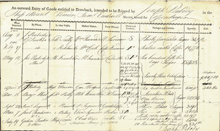
The Cargo: Drawbacks

The Cargo
Drawbacks and the Outward Entry of Goods
A merchant exporting goods was required to declare his intention to ship goods that were entitled to drawback; a very important concept which allowed merchants to receive a refund of the duties on goods that had been imported to the United States, but later exported. Along with bonds and other documents, the Entry of Goods for Drawback was part of an elaborate accounting paper trail used by the Collectors of Customs to verify that merchants were eligible for these refunds. On the form merchants were required to list the items being shipped and to indicate when, where, and by whom they were originally imported to the United States. Ships like the Mount Vernon were often almost completely loaded with cargo that had previously been imported from many different countries.
This form may seem to be oddly named and can cause confusion, since the use of the word "entry" might be thought to mean the entrance of goods, whereas this document is really about the exit, or exportation, of previously imported merchandise. However, "entry" is a special customs term which simply refers to the formal filing processes associated with imports. There were, and still are, many different categories of "entries" used by Customs officials.
Learn about:
